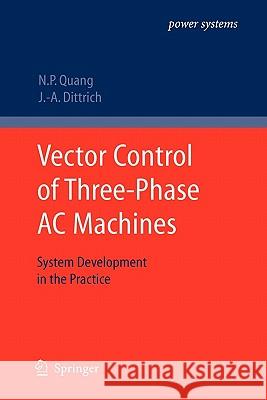Vector Control of Three-Phase AC Machines: System Development in the Practice » książka
Vector Control of Three-Phase AC Machines: System Development in the Practice
ISBN-13: 9783642097867 / Angielski / Miękka / 2010 / 340 str.
This monograph covers the area of vector control of three-phase AC machines, in particular induction motors with squirrel-cage rotor (IM), permanent excited synchronous motors (PMSM) and doubly-fed induction machines (DFIM), from the viewpoint of the practical design and development. Main focus is on the application of the IM and the PMSM in electrical drive systems, where the method of the field-orientated control has been successfully established in the practice, and on the use of the grid voltage orientated controlled DFIM in the wind power plants.
After a summary of the basic structure of a field-oriented controlled three-phase AC drive as well as of a grid voltage orientated controlled wind power plant the inverter control by space vector modulation is extensively discussed with the help of many examples to illustrate the practical application. Based on the basic machine equations, the continuous and the discrete machine models of IM, PMSM and DFIM are derived and questions regarding feedback acquisition and the practical implementation of the field-oriented control are highlighted. The design of vectorial two-dimensional current controllers using the discrete models is then discussed in connection with other essential problems like control variable limitation. Several alternative controller configurations are introduced. Further emphasis is given to determining the machine parameters by calculation from name-plate data and automatic offline parameter identification. Questions of energy efficient operation are addressed, particularly relating to efficiency and torque optimal control strategies under consideration of state variable limitations. Control concepts are proposed for the electrical system of wind-power plants with DFIM, an application which has gained wide-spread importance in recent years. The presented control concept is proven practically and can be regarded as pioneering for new developments. Control applications for AC drives usually feature linear algorithms in spite of the machine itself being characterized by a non-linear process model. Nevertheless, the introduced control structures have led to a relatively mature stage of development in the practice. Control approaches which take into account system nonlinearities from the outset may however fare better in a number of circumstances. Starting from the structural nonlinearity of the machines, the suitable nonlinear models are derived, and in the process nonlinear controllers are designed on the basis of the method of the "exact linearization" which proves to be the most suitable in comparison with other methods like "backstepping-based" or "passivity-based" designs. While compiling this book, the authors had been dedicated to expose the problems as close as possible oriented on practical and implementation-related requirements. The theoretical background is detailed as much as needed to understand the subjects; numerous equations, figures, diagrams and appendices support the detailed description of the design processes.











